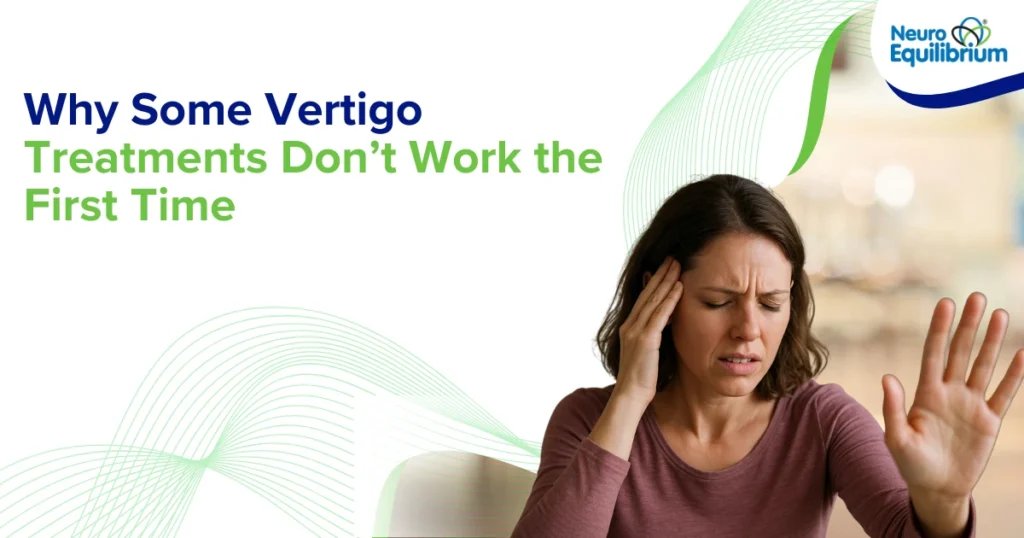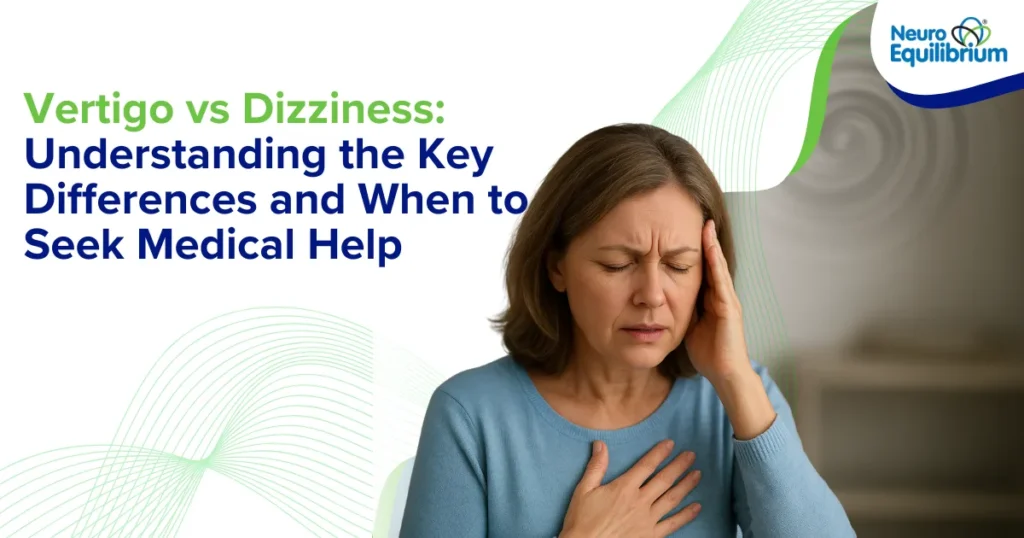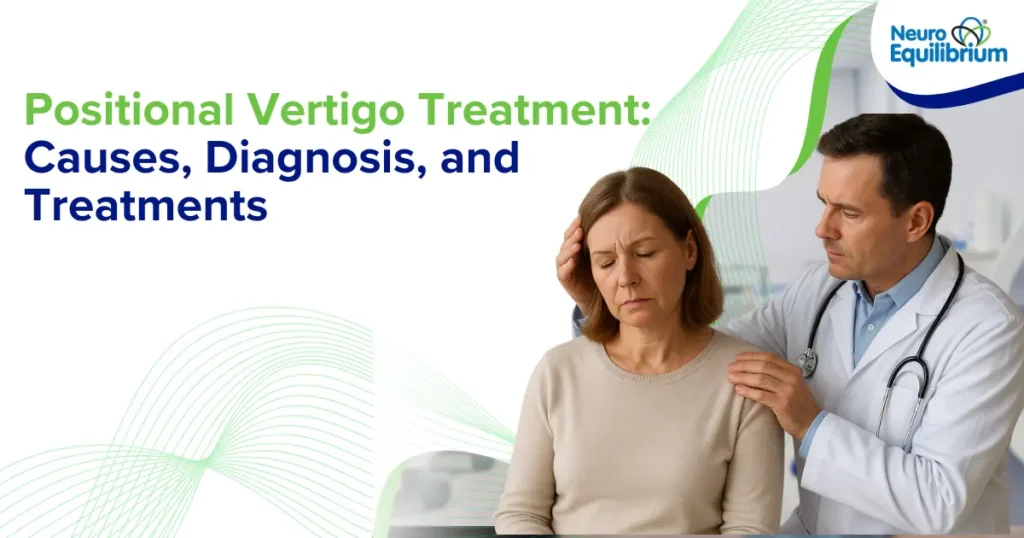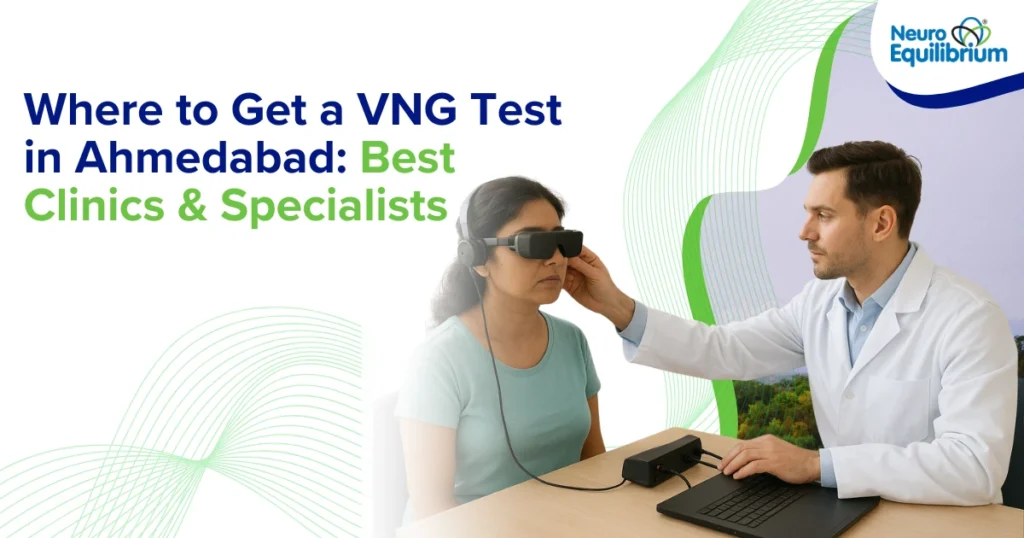Have you ever taken treatment for vertigo, only to feel the dizziness return the very next day? You’re not alone. Many people feel frustrated when the spinning doesn’t go away after just one session.
For some, treatment works quickly. But for others, it may take a few more sessions before the dizziness finally settles. In rare cases, the process can take longer than expected.
At NeuroEquilibrium, we treat thousands of patients every year. What we’ve seen time and again is this: when vertigo doesn’t improve right away, it usually means there’s another underlying cause that needs to be identified and treated.
What Is Vertigo and How Is It Treated?
Vertigo is more than just lightheadedness; it is the sensation that either you or your surroundings are spinning. It is often triggered by simple head movements, such as turning in bed, looking up or down quickly, or bending over.
The most common type is BPPV, which happens when calcium crystals (otoconia) in your inner ear become dislodged and move to areas where they shouldn’t be. Think of it as grains of sand dislodged into the wrong part of your inner ear’s balance system.These free-floating crystals send false signals to your brain, causing a sudden whirling sensation that can last a few seconds or minutes.
The most efficient and common treatment of BPPV is canalith repositioning procedure (CRP). The most well-known technique is the Epley maneuver, where a trained professional guides you through a series of simple head and body movements to reposition the loose crystals to their proper place.
The most efficient and common treatment of BPPV is the canalith repositioning procedure (CRP). Several maneuvers are used for this purpose, including the Epley, Semont, Foster (half-somersault), and Brandt-Daroff maneuvers. These involve guided head and body movements to reposition the loose crystals to their proper place.
In most cases, patients feel relief within one or two sessions. But not every case of vertigo is so straightforward, and that’s when the frustration begins. Sometimes the first treatment doesn’t fully work, not because the procedure was wrong, but because other factors are interfering.
Know More About Vertigo
- Is It Just a Migraine or Something More
- Why Do You Feel Unsteady on Your Feet?
- What Does Constant Ringing in the Ears Mean?
Why Vertigo Treatment Doesn’t Always Work the First Time
It can feel discouraging when vertigo treatment does not immediately solve the problem. The good news is that this is common and usually has an explanation. Research has identified three main reasons why some people need more than one treatment.
a) Underlying Ear Disorders
In numerous instances, BPPV is accompanied by an additional ear disorder. These disorders may resemble or complicate vertigo, and they complicate treatment.
Some of the more typical overlaps include:
- Sudden hearing loss- evident in about 12 percent of patients with BPPV. This can build up fast and may induce both hearing and balance.
- Vestibular neuritis- an inner ear infection or inflammation of the balance nerve, occurs in approximately 6 percent of BPPV patients.
- Meniere’s disease- a condition that produces vertigo, tinnitus, and hearing loss, and affects approximately 9 to 10 percent of patients with BPPV.
- Labyrinthitis – inflammation of the inner ear, which leads to vertigo and hearing problems, occurs in approximately 3 percent of cases.
In case of BPPV associated with such disorders, the dizziness might not be completely alleviated by a single treatment, as the balance system is being affected by more than one issue.
b) Other Health Conditions
BPPV is also linked with some medical issues outside the ear.These conditions can make the inner ear more sensitive or slow down recovery. Research indicates that patients with the following conditions may not respond fully to the first canalith repositioning procedure:
- Migraine – can produce vertigo on its own and often overlaps with BPPV.
- Diabetes and high blood pressure: They can affect the circulation to the inner ear and balance pathways.
- Osteoporosis and low vitamin D- This weakens the bone and inner ear structures, and crystal dislodgement becomes more frequent.
- Anxiety or head injury – Both these are associated with an increased risk of persistent symptoms.
Such medical conditions do not render BPPV treatment impossible, but they tend to lower the likelihood of a successful outcome at the first attempt.
c) The Type of BPPV
BPPV can affect different semicircular canals in the inner ear, and each canal requires a specific maneuver for effective treatment. Using the wrong maneuver or dealing with a more difficult-to-treat canal may result in persistent dizziness.
This is why accurate diagnosis is so important. Identifying which canal is involved enables the doctor to select the appropriate repositioning technique, thereby improving the chances of success.
Why Some Patients Need Repeat Treatments
For many people, vertigo improves after just one or two canalith repositioning procedures. However, some patients require more than one attempt before they feel better, and this is entirely normal. In rare cases, patients with complex conditions, such as severe head trauma or very low vitamin D levels, may require more maneuvers as compared to other people.
There are a few reasons why repeated treatments may be necessary:
- Crystals may not move back completely during the first maneuver, leaving some dizziness behind.
- Multiple canals may be involved in the same patient, which means different maneuvers are needed.
- Coexisting conditions, like Ménière’s disease or migraine, can continue to trigger vertigo even after a successful repositioning maneuver.
The need for repeated treatments does not mean the condition is incurable. Studies indicate that most patients recover with time and proper diagnosis. The important thing is to determine whether some other condition is affecting recovery, and modify the treatment accordingly.
The Role of Accurate Diagnosis
When vertigo doesn’t improve quickly with treatment, it’s often not because the wrong treatment was chosen, but because something might be being overlooked. There are many ear conditions and health issues that can resemble or add complications to BPPV, and missing these can lead to dizziness coming back. For example, someone might be diagnosed with BPPV but also have Ménière’s disease or sudden hearing loss. In such cases, just doing a repositioning maneuver might not completely fix the problem. Similarly, if a patient is being treated for Ménière’s disease or vestibular neuritis and continues to experience dizziness, they might also have undiagnosed BPPV. That’s why doctors recommend “mutual screening”: checking patients with BPPV for other ear issues, and examining those with ear problems like hearing loss or Ménière’s for BPPV too. Getting the right diagnosis really makes a big difference because it helps doctors choose the best treatment, tackle any underlying conditions, and come up with a plan that works better. Without this careful approach, patients might have to go through many treatments without finding long-term relief.

How NeuroEquilibrium Helps Patients Recover Faster
Vertigo can be frustrating, especially after initial treatments fail, but accurate diagnosis and proper care offer lasting relief. NeuroEquilibrium makes a difference with advanced vestibular testing devices that identify even small imbalances, enabling doctors to diagnose BPPV and other inner ear or neurological issues. This allows for personalized treatment by identifying affected canals and underlying conditions. Our team-based approach, integrating ENT, neurology, audiology, and therapy specialists, ensures comprehensive care and reduces the risk of missing hidden issues. Combining cutting-edge technology with professional care, most NeuroEquilibrium patients find lasting relief, even after other treatments fail. We aim to treat the whole person, addressing all aspects of vertigo to promote well-being.
When to See a Specialist?
Vertigo might clear up on its own over time with some simple home remedies or basic treatments, but that’s not always the case. If your vertigo keeps coming back despite trying all the recommended therapies, it could be a sign of a more serious health issue that needs extra attention. It’s also a good idea to see a specialist if you notice other symptoms like hearing loss, tinnitus (ringing in your ears), or a constant feeling of imbalance along with vertigo. These signs could indicate underlying conditions that require more specific treatment. If you’ve gone through multiple Canalith Repositioning Procedures and still feel dizzy, don’t hesitate to consult a healthcare professional again. They can help determine if you need to adjust your treatment plan or if another health problem might be affecting your recovery.Consulting a specialist can provide a clearer understanding of what’s happening and help develop a personalized, effective treatment plan.
Conclusion
It’s completely normal to need more than one treatment session to fully recover from vertigo. Remember, needing several visits doesn’t mean you’re not getting better; often, it simply means there’s another aspect affecting your balance that might need to be addressed.
Our caring team at NeuroEquilibrium is here to find out what’s causing your vertigo and create a personalized treatment plan just for you. Take the first step toward regaining your balance, book an appointment today.
Why doesn’t vertigo treatment always work the first time?
Other factors, such as underlying ear disorders, additional medical conditions, or involvement of multiple canals, may also affect the success of the initial treatment.
What is BPPV and how is it treated?
Benign paroxysmal positional vertigo (BPPV) appears when some solid particles of the inner ear move. It is normally managed with canalith repositioning maneuvers like the Epley procedure.
Can other health conditions affect vertigo recovery?
Yes. Other conditions can also factor in and impede healing such as migraine, diabetes, high blood pressure, osteoporosis, vitamin D deficiency, anxiety, or head injury, which may require repeat treatments.
Why might repeated treatment sessions be needed?
Crystals may not all fully settle in the first session, more than one canal may be involved, or a coexisting condition like Ménière’s disease or vestibular neuritis may cause ongoing vertigo.
When should I see a specialist for vertigo?
If vertigo comes back even after treatment, or if it is associated with hearing loss, tinnitus, or persistent dizziness, consulting a specialist can help track down the reasons behind them and devise a treatment plan.
















